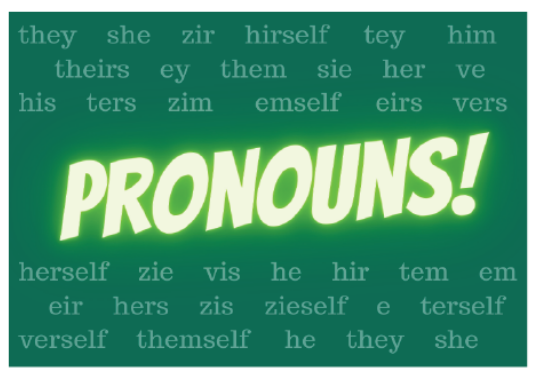Pronouns
You may have noticed that some people on campus share their pronouns when they introduce themselves or include their pronouns with their name in an email or on their name tag? This is happening to make our campus more inclusive of everyone from all genders. One way you can do this is to share your pronouns. Like names, pronouns are an important part of how we identify that deserves to be respected. And we recognize that assuming someone’s gender can be hurtful, especially to members of our community who are transgender, genderqueer, or gender expansive.
If this is new to you, don’t worry. As a community, we are all learning together about the importance of pronouns and being better allies to the trans communities on campus. We hope that you’ll join us in striving for inclusion and respect—because at Binghamton University, we welcome all. Including pronouns is a first step toward respecting people's gender identity and being a welcoming place for all.
Here’s a guide on what pronouns are, why they matter, and how to use new ones and support your trans friends! This video was written, filmed, and edited by Minus18.
Pronoun Etiquette
Pronouns come in many forms. They are linguistic tools that we use to refer to people, such as they/them/theirs, she/her/hers, he/him/his or even zie/zir/zirs. Someone’s pronouns inform us how to best refer to and honor them. It is not necessary to know someone’s gender identity or pronouns in advance of meeting them. Instead, you can use best practices for making every interaction inclusive and respectful:
Introduce yourself using your name and pronouns. Partially conjugate the pronouns you use during introductions – for example, “Hello, I am Taylor Adams, I use she/her/hers pronouns.”
- During introductions, don’t compel someone to share pronouns.
- Do not say “I use female pronouns” or “I use male pronouns.”
- Do not joke or say things like “Well, I use he/him/his pronouns, OBVIOUSLY.”
- Remember, learning someone’s pronouns does not tell you about a person’s identity, just how they’d like to be addressed.
- Practice! It’s OK to be uncomfortable with something new. Practice lessens discomfort.
Using Pronouns in Everyday Conversation
Here are some simple examples of non-binary pronouns used in everyday speech. Below you’ll have an opportunity to practice using non-binary pronouns.
- I saw Alex today walking their dog down the street. They recently rescued the dog from a shelter and I cannot wait to talk to them about their new puppy.
- Noel was in the meeting today and had a really good idea. Xe said that we could increase enrollment through better marketing and xyr idea could really help us out in the long run. We should talk to xem about it more at the next meeting.
- Jordan was wearing a really nice blue shirt today. Ey said ey recently bought it at eir favorite store.
Making a mistake is the number one concern when people are new to using a broader range of pronouns. Fear of making a mistake is also the top reason people give for not even trying. While not always OK, it is understandable that you may occasionally make a mistake with someone’s pronouns. If this happens, try not to draw a great deal of unnecessary attention to the person whom you misgendered.
If you catch yourself using the wrong pronoun, simply stop what you were saying, correct yourself, apologize to the person, and continue on with the conversation. If the person is not present and you use the wrong pronoun, it is still important that you stop and correct yourself. Remember, practice makes always makes better, especially when it comes to learning gender-neutral pronouns.
If you hear someone else make a mistake, please correct them. Being an ally is an active role, and it is your responsibility to correct people when they make a mistake. Remember, we all make mistakes sometimes and no one is perfect, so try to correct the person in a respectful way while still making sure they understand the importance of using the right pronoun.
Practice
Read each sentence in the madlib and match a pronoun from the corresponding column of the table to complete the sentence. Practice reading the sentence to familiarize yourself with pronouns that are new to you.

Call to Action
Email Signature Line
It has become quite common in diverse and inclusive environments to add your pronouns in your email signature. This practice helps minimize misgendering and is an important strategy towards inclusivity. Below you will find some samples that you may incorporate in your email signature. Also, you can copy the "what's this" hyperlink to add after your pronouns in your email signature to help educate others and promote this call to action.
Shane Correy (she/her/hers - what is this?)
Associate Faculty Member
Graduate School
Shane Correy
Associate Faculty Member
Graduate School
Pronouns: xe, xer, xem what is this?
Shane Correy
Pronouns: they, them, theirs (what is this?)
Associate Faculty Member
Graduate School
Shane Correy
Associate Faculty Member
Graduate School
Use of Honorifics
An honorific is a form of address indicating respect. These can be titles prefixing a person's name, such as Mr. Nagisa, Ms. Weinberg, or Mx. Rosales. The only way to know the honorific to best refer to someone is to ask, similar to using pronouns.
Mx: Pronounced “mix,” this is an alternative to common gendered honorifics such as Mr. and Ms. It is often used by trans and non-binary people, or those who do not wish to be referred to by gendered honorifics.
- Dear Mx. Schwartz…
- I would like to welcome Mx. Singh to the podium.
- Ms. and Mx. Parrish are a wonderful couple.
Ms: A gendered honorific to refer to women, but not always.
- In the 20th century, “Ms.” was revived as a result of the inherent sexism in women's honorifics that indicate a woman's marital status. Previously “Miss” was used to indicate an unmarried woman and “Mrs.” meant a woman was married. There is no such distinction in the men’s honorific, which has been limited to “Mr.” For this reason, among gendered honorifics, the use of Ms. is preferred as it sheds a sexist gender distinction.
Mr: A gendered honorific often used to refer to men, but not always.
Start a Conversation
Starting a dialogue about the importance of pronouns can be informative and powerful. Here are a few quick, one-sentence explanations you can use to explain why it's important to share pronouns!
- I share mine because I don’t want anyone to feel unsafe or unwelcome and I think this helps.
- I think that sharing my pronouns helps everyone feel included and respected.
- If we just asked trans people to share them, it would put them on the spot or make them carry the burden.
- Sharing my pronouns helps make my workspace more welcoming to Bearcats of all genders.
- I want to make sure that everyone gets my name and pronouns right every time. I want to make sure I get everyone else’s name and pronouns right, too!
- I think it’s more respectful not to assume someone’s gender based on how I think they look. I’m sharing mine so that you won’t have to assume either!
- I share mine because I am an active ally to the LGBTQIA+ community.
- I share mine because I am so proud to be trans, and having the chance to share my pronouns at work is phenomenal!
- I share my pronouns so that people have the chance to remember that assumptions about gender hurt us all.
- Because I always want to fight prejudice against transgender, genderqueer, and non-binary people whenever and wherever I can.
- I believe in radical acceptance and unconditional love.
